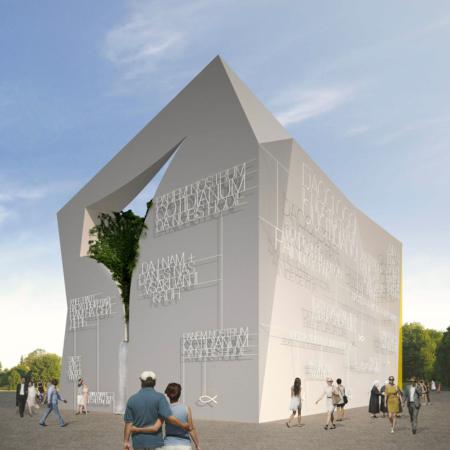At Expo 2015, Vatican pavilion offers space for learning, relaxation
MILAN (CNS) -- The Holy See's official pavilion at the Milan Expo 2015, the newest edition of the every-five-years world's fair, will be a public space of relaxation and learning.
But for the next six months, the pavilion also will be a place for formal studies, symposiums and academic conversations related to an examination of global food security, hunger and nutrition.
One of 140 countries represented at this year's "Universal Exposition," the Vatican chose for its pavilion the theme: "Non di solo pane" (Not by Bread Alone). It is designed in part as a garden-style space promoting agriculture, sharing meals and recognizing God's presence in the world, according to developers.
The theme is a Gospel-infused variation of the overall theme of Milan Expo 2015, which is "Feeding the Planet, Energy for Life." Expo Milan 2015 is expected to draw more than 20 million visitors to its 1.1 million square meters of exhibition area for the next six months.
The pavilion was developed, built and managed in a partnership of the Vatican's Pontifical Council for Culture, the Italian bishops' conference and the Archdiocese of Milan, along with the Pontifical Council Cor Unum.
Milan's Catholic University of the Sacred Heart and Bambino Gesu children's hospital were scientific partners, helping develop and support the theme for the pavilion, which is open to the public from May 1 to Oct. 31 at the Expo site, 10 miles northwest of Milan's city center.
The Vatican's website for the Pavilion notes that in papacies from Pope Pius IX to Pope Benedict XVI, the Vatican has taken part in international exhibitions "to demonstrate the church's desire to make her voice heard and to offer her testimony regarding the delicate themes, relevant to the future, that are from time to time proposed by the expositions, especially in recent decades."
Some recent Holy See pavilions at past world's fairs tended to emphasize sacred art and functioned almost as a mobile Vatican museum and small chapel space curated for a specific Expo themes such as The Oceans and water.
This year's pavilion-creation team sought less to create a kind of official chapel for Expo; it is not adorned with overt Christian symbolism, but does display the words, "Give us this day our daily bread" in 13 languages.
An off-white, minimalist exterior structure is among the smallest of the national pavilions at Milan Expo and is adorned with a yellow fabric entrance suggesting the Vatican flag colors. Inside the 747-square-foot pavilion, four concepts are expressed: ecological, economical-trade, educational and religious.
At least two noteworthy works of sacred art are on loan to the pavilion in order to adorn the interior: a tapestry rendering of Peter Paul Rubens' "The Institution of the Eucharist," and a painting, "The Last Supper," by Renaissance painter Tintoretto. Photo exhibitions and video installations will support the pavilion themes.
The Holy See Pavilion will be host to panel discussions, symposiums and film presentations addressing world hunger, food sustainability, care for the environment, diet and nutrition, and a theological conversation on the relationship between food and mankind.



















